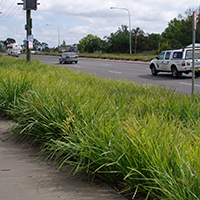Breeding more drought tolerant, lower maintenance, uniquely Australian plants.
Breeding more than 30 varieties of Plants requires more than just luck and chance, it involves planning, thought and inspiration. The new generation of home gardeners will hopefully relate to my sources of inspiration, as I am sure many of my breeding goals are their gardening goals.
Coming from a household, where both my wife and I worked, and having to parent 3 children, inspired me to find ways to make gardening easier and less maintenance. I only used plants that could be neglected in my home garden. Before starting to breed plants, I founded and ran a large native nursery, supplying tens of millions of plants to developments such as roadsides, golf courses, housing developments, and the Sydney 2000 Olympics. This gave me an insight into what native plants did well in the commercial landscape, and inspired me to even get further behind our native plants, that give Australia its unique character. It became obvious to me, that unfortunately, many of our natives, although tough, were too untidy looking and not showy enough for the general public to use. As proof of this point, I remember sitting in on a discussion group back in the mid 90’s. Landscapers, designers, garden writers, and nurseries, all discussing how do we get people to plant more natives. The biggest point to come out of the discussion was the fact that natives looked untidy and not as appealing compared to exotic species. After more discussion, the group realised that the exotic plants they were talking about were all varieties that had undergone decades or centuries of breeding, and that is why they looked so good. The common ancestors of the plants they loved so much were no longer used. This was one of the events that set off a light bulb in my head. I said to the group, ‘Then what is needed is to take these good common natives, and through selection and breeding, develop better looking, tidier forms of these tough native plants.’
After this initial inspiration, I had to focus. What do customers need? I am a firm believer in breeding for the consumer, rather than coming up with a plant, and then trying to talk the customer into it. Talking to the head Landscape Architect of the NSW roads and traffic authority was a great place to start. I asked him, ‘what do you want in roadside plants’. I was told, plants that rarely if ever needed maintenance, plants that can live on natural rainfall (No Irrigation), and most importantly more compact tidy looking plants that when planted on mass, out compete weeds. I realised that native plants from the genus Lomandra and Dianella fulfilled many of these objectives, except for the more compact tidy aspects. To breed these new plants, I realised I needed to use environmentally friendly breeding techniques, such as natural selection. I avoided controlled hybridising, or other similar techniques that could possibly change the plant and cause it to be detrimental to the environment. We selected plants that either produced no seed, or very little, and if they did produce offspring, they would revert back to common forms, so as to not influence the natural gene pool. The natural environment was another important inspiration for me. The plants chosen also needed to be stable from division or Tissue Culture, ensuring the customer got the same type that was originally bred.
Lomandra ‘Katrinus’ was the first of these types of plants I bred. It was more tidy and uniform. From Katrinus came one of the most popular plants from our stable, the compact fine leaf Lomandra longifolia ‘LM300’ which is marketed under the brand name of Tanika. This plant changed how people thought of Lomandra. What would the original discussion group be saying now, knowing that a bred Australian native plant, namely Tanika, was and integral part of the gold medal winning display at Chelsea in England in 2006? The Queen of England even spent time looking at many of the native plants I developed, which were well represented in the display. Our native plants are now more tidy, and at home competing with other exotic plants around the world.
After this I managed to breed and select an array of more tidy compact and tough native plants; plants such as the popular compact, blue Grey LITTLE REV Dianella revoluta ‘DR5000’, and the great looking TASRED Dianella tasmanica ‘TR20’. CASSA BLUE Dianella caerulea ‘DBB03’ has become a home gardener’s favourite for providing blue foliage colour both in Australia and overseas. LITTLE JESS Dianella caerulea ‘DCMP01’ with its beautiful purple flowers, is now being used all over Australia, and the USA instead of Liriope.
I now hope to use this same inspiration to breed new native trees, shrubs and ground covers; new plants that have all the natural toughness and drought tolerance of our hardiest natives, with the beauty, compactness, and tidy appearance of many exotic plants that have gone through many generations of plant breeding.


